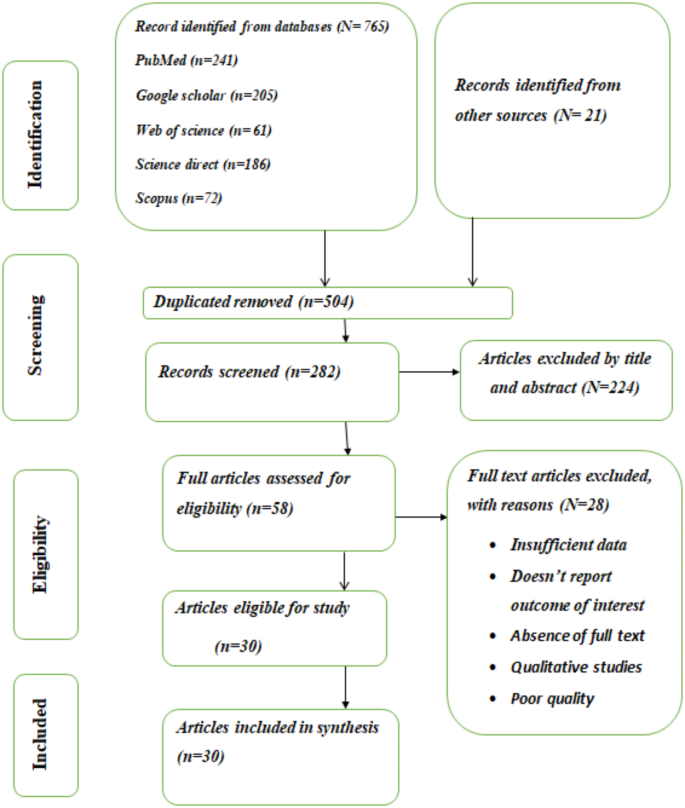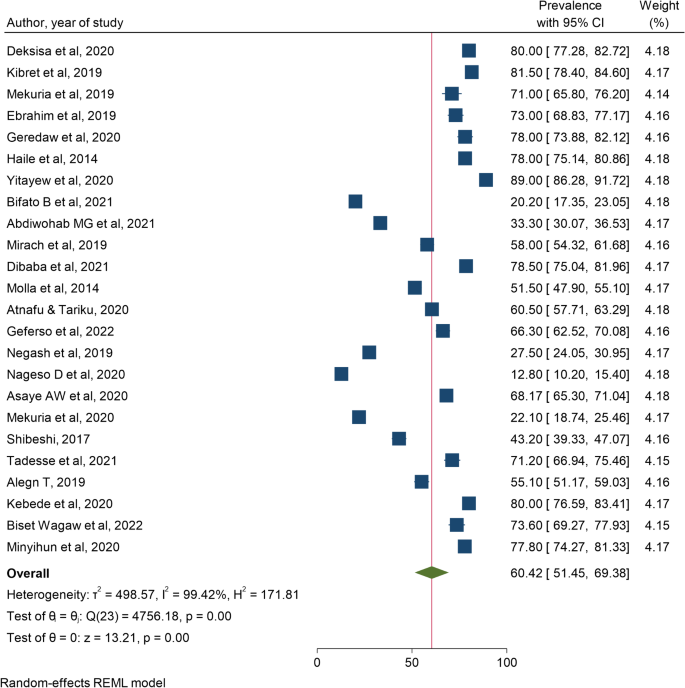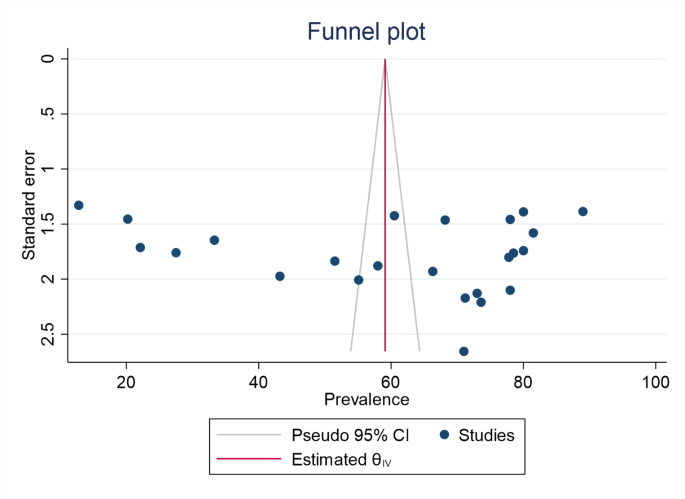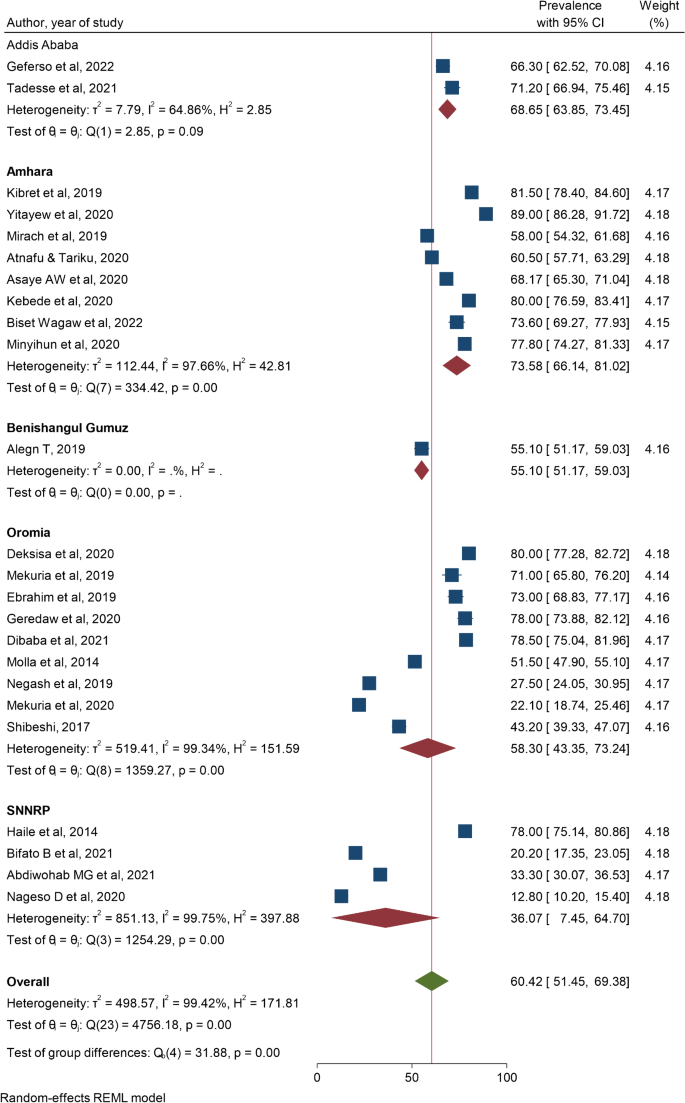Cost Effectiveness and Resource Allocation volume 23, Article number: 12 (2025) Cite this article
In Ethiopia, out-of-pocket medical expenses make up one-third of all medical expenses, which makes it difficult for households to obtain and utilize healthcare. One of the prepayment mechanisms that shield low-income households from unaffordable medical bills is the community-based health insurance (CBHI) program. This systematic review and meta-analysis aimed to estimate the pooled willingness to join Community-based Health Insurance schemes and its associated factors among households in Ethiopia.
Articles were searched from PubMed, Google Scholar, Web of Science, Scopus, Science Direct, and Ethiopian Universities’ repositories for grey literature. The study used the modified PRISMA guidelines for rewriting and reviewing the literature. The quality of studies was assessed using Joanna Briggs Institute Critical Appraisal tools. Data was extracted using Microsoft Excel and exported to STATA version 16 software for analysis. Cochran’s Q statistic and I2 tests were utilized to determine the heterogeneity between studies. Studies publication bias was determined using a funnel plot and Egger’s test. Subgroup analysis was conducted to demonstrate variations of the effect sizes across study regions. Finally, we utilized a random-effect model to compute the overall willingness to join the CBHI scheme and its determinants among households in Ethiopia.
We included thirty studies to determine the pooled prevalence of willingness to join the CBHI scheme and its determinants. The pooled magnitude of households’ willingness to join the CBHI scheme was 60.42% (95% CI: 51.45%, 69.38%). Old aged (AOR = 2.17, [95% CI: 1.37, 3.44], I2 = 82.33%), formal educational status(AOR = 2.74, [95% CI: 2.10, 3.56], I2 = 59.85%), Rich wealth index (AOR = 2.51, [95% CI: 1.99, 3.18], I2 = 48.25%), good knowledge/awareness of CBHI scheme(AOR = 4.21, [95% CI: 3.01, 5.88], I2 = 66.0%), experienced illness in the last three months (AOR = 3.42, [95% CI: 2.19, 5.35], I2 = 71.15%), and large family size (AOR = 2.36, [95% CI: 1.95, 2.87], I2 = 50.81%) were determinants of willingness to join the CBHI scheme. In addition, affordability of CBHI premium (AOR = 3.12, [95% CI: 2.34, 4.14], I2 = 10.35%), poor health status (AOR = 3.23, [95% CI: 2.57, 4.06], I2 = 35.97%), trust in scheme (AOR = 4.38, [95% CI: 1.91, 10.06], I2 = 88.35%), chronic diseases (AOR = 3.24, [95% CI: 2.40, 4.37], I2 = 67.15%) and good quality of healthcare services (AOR = 2.91, [95%CI:2.08, 4.09], I2 = 65.40%) were also predictors of willingness to join the CBHI program.
The pooled prevalence of willingness to join the CBHI scheme was low and below the national target of 80%. Age, family size, educational status, wealth status, illnesses in last three months, presence of chronic illnesses, affordability of the premium for the CBHI scheme, self-reported health status, Knowledge/awareness of the scheme, trust in the scheme and perceived quality of healthcare service were significantly determine the willingness to join the CBHI scheme. Health providers should provide detailed awareness creation through health education on the concepts and principles of the CBHI scheme.
Approximately 200 million people worldwide experience catastrophic health costs each year, with over 90% of these cases occurring in low- and middle-income countries (LMICs) [1]. Due to the low coverage of prepayment methods and underfunded public health systems in LMICs, out-of-pocket payments (OOP) have been a means of paying for medical services for the past ten years [2]. High OOP medical expenses were a major challenge in achieving universal health coverage (UHC) for sub-Saharan African(SSA) Countries including Ethiopia [3, 4]. In Ethiopia, OOP expenses for households make up one-third of all medical expenses, which makes it difficult for households to obtain and utilize healthcare [5].
To overcome financial hardship during service delivery, the government introduced prepayment modalities [6]. The community-based health insurance (CBHI) is a voluntary type of health insurance designed to shield low-income households from unaffordable medical bills, which is a part of the 2005 healthcare finance reform and receives significant government subsidies [7, 8]. After the reform, the CBHI program became a popular way to increase the health expenditures per capita, healthcare utilization, and health facilities service qualities in Ethiopia [8,9,10,11,12]. Although the CBHI scheme is crucial in avoiding financial hardship and improving healthcare quality in Ethiopia, the use of such strategies has been limited by the low coverage of the program [7]. The households’ willingness to join the CBHI scheme varies from region to region. For instance, the household enrollment rate was 73%, in the West Arsi zone [13], 78%, in the Bench Maji zone [14], and 12.8%, in the Sidama zone [15]. Socioeconomic factors (i.e. age, sex. Education, occupation, income, and family size), health and health-related factors (distance to facilities, health status, chronic illness, illnesses in family members, and quality of healthcare), CBHI-related factors (affordability of premiums, trust of households’ towards CBHI premium management, knowledge, and attitude towards CBHI program) were found to determine the CBHI scheme uptake [14,15,16,17,18,19,20,21,22,23,24,25,26,27,28,29,30,31,32,33,34,35,36,37,38,39].
In Ethiopia, comprehensive evidence of households’ level of willingness to join the CBHI scheme is still needed using a systematic review and meta-analysis from primarly studies to amend insurance policies and decide on the program at the national and regional levels. There are two published studies which assessed the pooled uptake of the CBHI scheme in Ethiopia after our review was submitted for publication. The first systematic reviews and meta-analysis conducted by Tahir et al. [40] included 17 studies published from 2016 to 2020 to determine the pooled coverage of community-based health insurance scheme enrolment in Ethiopia. However, this review missed important studies [13, 16, 25, 28, 31, 33,34,35,36] on CBHI enrolment and used a magnitude from case-control studies [18] to determine the pooled magnitude of CBHI uptake. In addition, this systematic review and meta-analysis included studies done on dropout rate/membership renewal [41, 42], compliance [43], and the impact of CBHI on healthcare utilization and quality of life [44,45,46] to determine the pooled CBHI enrolment in Ethiopia. Thus, the studies dealing with dropout rate, membership renewal, the effect of CBHI on healthcare utilization, and compliance with a requirement of the CBHI scheme must be treated as unreliable sources of evidence for pooled CBHI uptake. In our review, we selected the dropout rate/membership renewal studies in the review only when they also dealt with CBHI uptake or enrolment as outcome variables. Besides, the recent systematic review and meta-analysis done by Habte et al. [47] included 15 studies published from 2017–2022(11 Cross-sectional and 4 Case-control) to determine the pooled magnitude of CBHI enrolment in Ethiopia. However, this study also missed pertinent studies [13, 16, 21, 24, 28, 30, 31, 33, 34, 36] while synthesizing evidence on CBHI uptake which might undermine the national figure to some extent. Thus, our systematic review and meta-analysis aimed to fill the above-mentioned gap and planned to determine the pooled magnitude of households’ willingness to join the CBHI scheme and its determinants in Ethiopia.
The preferred reporting items for systematic review and meta-analysis (PRISMA) 2020 guidelines were followed for rewriting and reviewing the literature [48]. The protocol of this systematic review and meta-analysis was registered at PROSPERO databases and available from https://www.crd.york.ac.uk/prospero/display_record.php?ID=CRD42022304861.
Both published and unpublished articles were searched in PubMed/Medline, Google Scholar, Web of Science, Science Direct, Scopus, and Ethiopian Universities’ repositories from January 31, 2022 to March 28, 2022. Medical Subject Heading (MeSH) and keywords such as (“Willingness to join“[All Fields] OR “enrolment“[All Fields] OR “adoption“[All Fields] OR “Uptake“[All Fields] OR “participate“[All Fields] OR “utilization“[All Fields]) AND (“community-based health insurance“[All Fields] OR “Community Health Insurance“[All Fields] OR “health insurance“[All Fields] OR “Mandatory Health Insurance“[MeSH Terms]) AND (“Ethiopia“[MeSH Terms] OR “Ethiopia“[All Fields])” combined with boolean operators were utilized to retrieve relevant studies from the electronic database (S1). Likewise, the authors retrieved a few relevant articles by searching the reference lists of included studies that might have been omitted during electronic database searching.
Inclusion criteria
The review included both published and unpublished observational (Cross-sectional and case-control) studies conducted in Ethiopia, articles published in English, and studies performed since 2010 were considered. In addition, we used condition, context, population, and exposure of interest (CoCoPop/PEO) to frame the eligibility criteria. Population: included urban or rural Households, whereas exposure of interest included determinants factor that affects households’ level of willingness to join the CBHI scheme in Ethiopia. Condition/outcome: The primary outcome of the study includes Households’ willingness to join CBHI, defined as the motivation for heads of households to enroll in voluntary health insurance to benefit from the program, regardless of the payment, and is assessed using closed-ended binary questions after the principle and concept of the scheme are explained. The determinants of household willingness to join the CBHI scheme were the secondary outcome, measured using odds ratio (OR) and calculated based on the odds ratio and 95% Confidence Interval(CI) from primary studies included in the analysis. Secondary outcomes include socioeconomic factors (age, wealth index, educational status, and family size); environmental factors (travel time or distance to health facility); and health and health-related factors (self-reported health status, chronic illness, or any illness in the last three months and perceived quality of healthcare), the CBHI related factors (premium affordability, participation in solidarity organization, knowledge, and attitudes towards the CBHI scheme).
Exclusion criteria
Studies conducted in other than English languages, did not report outcomes for willingness to join the CBHI scheme, were not fully accessible, had methodological problems, editorial, qualitative studies, case reports, conference reports, reviews, commentary, letters, and studies done outside of Ethiopia were excluded from the study.
We used the PRISMA reporting guidelines to screen the retrieved articles and select the relevant studies. Duplicated articles were removed using EndNote reference manager software version X7. Then, two reviewers (AWK and HEH) assessed the retrieved articles for title and abstract, and irrelevant titles and abstracts were removed. Finally, the remaining articles were reviewed for the full-length texts against the selection criteria. Disagreements between two reviewers during the study selection process were resolved by discussion with a third reviewer (BGD).
Two Reviewers (AWK and HEH) independently extracted data for each included article using a data abstraction format designed in Microsoft Excel. For each article, the authors extracted the following information: study design, region, publication year, sample size, response rate, the magnitude of willingness to join the CBHI scheme, and its associated factors. We developed the abstraction form containing the Odds ratio and 95% CI for extracting the determinants of willingness to join the CBHI scheme. In this systematic review and meta-analysis, we included the determinants of households’ willingness to join the CBHI program if they were reported as determinants in at least four studies.
An essential component of systematic reviews and meta-analyses is critical appraisal, which assesses the quality of published articles, descriptions, reporting standards compliance, internal validity, and analysis methodology. Joanna Briggs Institute’s (JBI) quality check tool for observational studies was used to appraise the quality of each study. The JBI quality appraisal checklist for prevalence and case-control studies has nine and ten parameters, respectively [49, 50]. Two reviewers (AWK and HEH) independently assessed the quality of each study. The reviewers provided a score of ’1’ if the study met each specific parameter and ‘0’ if not the case. Next, using the JBI criteria to determine the risk of bias, the scores were computed, translated to percentage, and classified as poor quality/high risk of bias (≤ 49%), moderate quality/moderate risk of bias (50–69%), and excellent quality/low risk of bias (≥ 70%) [51, 52].
Relevant data were extracted using Microsoft Excel and imported into STATA 16 for analysis. Cochran’s Q-statistic and I2 statistics were used to assess the heterogeneity of the included papers; I2 values of 25%, 50%, and 75%, respectively, indicate low, moderate, and high heterogeneity [53, 54]. Leave-one-out sensitivity analyses were used to determine the source of heterogeneity among studies. The pooled prevalence of households’ willingness to join the CBHI scheme was estimated using random effect meta analysis because the included studies have high heterogeneity. The determinants of households’ willingness to join the CBHI scheme were reported using pooled odds ratio with 95% confidence intervals. Sub-group analysis by region was also done to present the variation in the level of willingness to join the CBHI program across study areas. The presence of publication bias was checked using Egger’s tests at a 5% significant level and by visual inspection of the funnel plot for the symmetry of the study heterogeneity. Lastly, the pooled estimates for willingness to join the CBHI scheme and its determinants were displayed using forest plots along with the appropriate 95% confidence intervals.
A total of 786 records were identified from electronic databases and other sources, out of which 504 were duplicated. After excluding duplicated studies, 224 studies were further removed based on titles and abstracts, and 58 full-text articles remained. After rigorous screening of the remained full-text articles based on eligibility criteria, 28 records were removed. The criteria for exclusion of the full-text articles include studies with insufficient data, methodological problems, reviews, that didn’t define the outcome of interest appropriately, qualitative studies, poor quality studies, and studies conducted outside of Ethiopia. Finally, we found 30 studies (24 cross-sectional and 6 case-controls) were eligible for the final systematic review and meta-analysis (Fig. 1).
Flowchart for a systematic review and meta-analysis of willingness to join the CBHI scheme and its associated factors in Ethiopia, 2022
This systematic review and meta-analysis included thirty (24 cross-sectional and 6 case-control) studies for final analysis and synthesis. The review includes eleven studies from Amhara [17, 18, 20, 24, 27, 28, 30, 31, 36, 39, 55], and eleven studies from Oromia [13, 16, 21, 22, 25, 29, 32,33,34,35, 56], and four studies from the SNNPR region [14, 15, 19, 26] and two studies from Addis Ababa city [23, 38] and one studies from Somali [37] and Benishangul Gumuz [57]. The included studies were done between 2014 and 2022 and a majority (18/30) of them were published after 2019. The sample sizes of the studies varied from 216 to 2008, with a total sample size of 18,739 (Table 1).
Out of 30 studies, 24(twenty-four) of them were used to compute the pooled prevalence of willingness to join the CBHI scheme. The I2 statistics result showed a high heterogeneity for the study (I2 = 99.17%, P-value < 0.01). Therefore, a random-effect model with a DerSimonian and Laird random method was used to determine the pooled prevalence of willingness to join the CBHI scheme in Ethiopia. Meta-analysis of 24(twenty-four) studies revealed that the pooled prevalence of willingness to join the CBHI program among households in Ethiopia was 60.42%(95%CI:51.45,69.38) [13,14,15,16,17, 19,20,21, 23,24,25,26, 28,29,30,31, 33,34,35,36, 38, 39, 56, 57]. We found the highest willingness to join the CBHI scheme in the study done in Simada District, Ethiopia, 89% [28], and the lowest willingness to join the CBHI scheme was observed in Sidama Zone (12.8%) [15] (Fig. 2).
Forest plot for the pooled prevalence of households’ willingness to join the CBHI scheme in Ethiopia, 2022
By visually inspecting the symmetry Funnel plot of the included papers and applying Egger’s and Begg’s tests, we evaluated the possibility of publication bias. The included studies were distributed symmetrically, and the visually examined funnel plot demonstrated that there was no publication bias. We also conducted Eggers-Egger’s and Begg’s tests, which yielded p-values of P = 0.332 and P = 0.823, respectively, and revealed no indication of a small-study effect (Fig. 3).
Funnel plot for publication bias of studies reporting willingness to join the community-based health insurance in Ethiopia, 2022
We performed the subgroup analysis to compare the willingness to join the CBHI scheme across study areas. The finding showed that the overall willingness to join the CBHI scheme was higher in Amhara [73.58%, 95% CI: (66.14–80.02%)] [17, 20, 24, 28, 30, 31, 36, 39] while the lowest pooled prevalence of willingness to join the CBHI scheme was found in SNNPR[36.07%, 95% CI: (7.45–64.07%)] [14, 15, 19, 26] (Fig. 4).
Magnitude of households’ willingness to join Community-based Health insurance by region in Ethiopia, 2022
Table 2 shows the willingness to join the CBHI scheme sensitivity analysis for every study that omitted one at a time. A leave-one-out sensitivity analysis was carried out on willingness to join the CBHI scheme among households in Ethiopia to pinpoint the possible cause of the analysis’s variability. We discovered that no single study had an impact on the households’ overall willingness to join the CBHI scheme(Table 2).
In this systematic review and meta-analysis, we included 30 primary studies to investigate the pooled prevalence of willingness to join the CBHI programs and its determinants in Ethiopia. The odds of households’ willingness to join the CBHI program among old-aged households were almost two (AOR 2.17, [95% CI: 1.37, 3.44], I2 = 82.33%), p < 0.001 times higher than in young households. The households whose family size was ≥5 were 2.36 times more likely to join the CBHI scheme than their counterparts (AOR 2.36, [95% CI: 1.95, 2.87], I2 = 50.81%), p < 0.001. The random effect of the meta-analysis found that respondents with formal education were 2.74 times more likely to participate in the CBHI program than their counterparts (OR = 2.74, 95%CI: 2.10, 3.56], I2 = 59.85%). Households with a rich quintile wealth index were approximately three times more likely to join the CBHI scheme than their counterparts (AOR = 2.51, [95%CI:1.99–3.18], I2 = 48.25%).
Households that had poor health status had 3.23 times higher odds of joining the CBHI scheme than those that had good self-reported health status (OR = 3.23, [95% CI: 2.57, 4.06], I2 = 35.97%). The odds of households who encountered illnesses in the last three months were almost 3.42 times higher compared to their counterparts (AOR = 3.42, [95% CI: 2.19, 5.35], I2 = 71.55%). Households that had chronic illnesses were 3.24 times more likely to join the CBHI scheme than those that had no underlying diseases (AOR = 3.24, [95% CI: 2.40, 4.37], I2 = 67.15%).
The likelihood of joining the CBHI scheme was 2.91 times higher among participants who perceived that public healthcare quality is good compared with their counterparts (OR = 2.91, [95% CI: 2.08, 4.09], I2 = 65.40%). In addition, respondents who could afford the CBHI scheme premium had 3.12 higher odds of joining the CBHI scheme than those who could not afford it (AOR: 3.12, [95% CI: 2.34, 4.14], I2 = 10.35%). Moreover, households who had trust in the CBHI scheme were 4.03 times more likely to join the CBHI program than their counterparts (OR = 4.38, [95% CI: 1.91, 10.06], I2 = 88.35%). Furthermore, respondents who had good knowledge of the CBHI program were almost four times more likely to join the CBHI scheme than those who had poor knowledge of the CBHI scheme (AOR = 4.21, [95% CI: 3.01, 5.88], I2 = 66.0%), p < 0.001(Table 3).
World Health Organization recommended countries should implement prepayment mechanisms to achieve UHC and overcome catastrophic financial costs for health service users [33]. Community-based health insurance schemes are the best to protect poor households against catastrophic healthcare expenditures [7]. This systematic review and meta-analysis intended to estimate the pooled prevalence of households’ willingness to join the CBHI scheme and its determinants in Ethiopia. The pooled prevalence of households’ willingness to join the CBHI scheme in Ethiopia was 60.42% (95%CI: 51.45, 69.38). This finding is almost comparable with the study conducted in Nigeria, 59.4% [58], and Kenya, 62% [59]. However, this finding is higher than the study conducted in Cameron, 46% [60], Uganda, 44% [61], and Kenya, 46% [62] and lower than the findings of a study done in Nepal, 88% [63], Nigeria, 90% [64], Enugu State, Nigeria, 92.4% [65], and the national coverage target, 80% [7]. The reason for the discrepancy might be due to the study period, study area, level of awareness about the CBHI scheme as well as the perception of participants towards the CBHI scheme.
The meta-analysis revealed that the old-aged respondents were more likely to join the CBHI program than young individuals. This finding is consistent with the findings of previous studies [66, 67]. This is explained by the fact that older groups are prone to illnesses and visit health facilities frequently for diseases that may expose them to financial hardship. Thus, this will encourage older age groups to join the CBHI to cover their healthcare costs during their illness. The study also found respondents who attended formal education had higher odds of joining the CBHI scheme than their counterparts. This finding is supported by previous meta-analyses [65, 68, 69], which showed education is positively associated with households’ willingness to join the CBHI scheme. This might be explained by the fact that educated households have a better understanding of the principles and benefits packages of the CBHI program in addition to their good know-how regarding the benefit of joining the CBHI program to overcome catastrophic health expenditure. In addition, the meta-analysis showed that households with larger family sizes were more likely to join the CBHI program than households with smaller family sizes. This finding is similar to the findings of previous studies [68,69,70]. This is because respondents with large family sizes might face a higher risk of illnesses and suffer from financial risks, particularly in poor communities. So, they prefer to join the CBHI scheme to avoid the risk of catastrophic out-of-pocket payment during the time of illness. Furthermore, households with a rich wealth index had higher odds of joining the CBHI scheme than those who had a poor wealth index. This finding is supported by previous systematic and meta-analyses [68,69,70] which reported income as a significant determinant of willingness to join the CBHI scheme. This is explained by the fact that individuals who have a rich wealth index can afford the CBHI scheme contribution at any price.
This meta-analysis found that households who experienced illnesses in the last three months had higher odds of joining the CBHI program compared to their counterparts. This evidence is supported by findings from previous studies [68, 70, 71]. This study also revealed that households who reported poor health status were more likely to join the CBHI scheme compared with their counterparts. This finding is in line with the study done by Bayked et al. [70] and Dror et al. [68]. This is because individuals who have poor health status experience more illnesses and visit public health facilities frequently which might expose them to catastrophic out-of-pocket healthcare expenditure that increases their probability to join the CBHI scheme. Besides, this meta-analysis showed that households who had chronic illnesses had higher odds of joining the CBHI program than those who had no underlying disease. This finding is consistent with the report of the studies [68, 70, 71]. This is explained by the fact that respondents with underlying diseases had frequent visits for follow up which exposed them to financial risk that forced them to join the CBHI scheme. Furthermore, the Meta-analysis revealed households who perceived the quality of healthcare services as good were more likely to join the CBHI scheme than their counterparts. This finding is supported by the Meta-analysis in LMICs [66,67,68, 70, 71], which reported quality of healthcare as facilitators of CBHI uptake. This might be due to the presence of good quality of healthcare in public health assists the households to get effective and efficient services that motivate them to join the CBHI scheme.
In this systematic review and meta-analysis, we found that households who perceived CBHI premium as affordable were more likely to join the CBHI scheme compared to their counterparts. This finding is concurrent with the previous studies [68, 71], which found affordability of the CBHI contribution is positively associated with CBHI uptake. The study also found household heads who trust scheme management had a higher likelihood of joining the CBHI scheme than those who did not trust the scheme management. This report is in line with the findings of the previous systematic review and meta-analysis [66, 67], which found trust in CBHI scheme management as facilitators of enrolment in the program. In addition, this meta-analysis points out that the households who good knowledge/awareness were more likely to join the CBHI scheme compared to their counterparts. Previous systematic reviews and meta-analyses [66,67,68, 70] also reported having knowledge/awareness of the CBHI scheme was positively associated with enrolment in the CBHI scheme. This might be because individuals who had awareness of the CBHI scheme principle and concept understand the advantage of joining the CBHI scheme. Our study has several limitations. Firstly, we didn’t get data from all regions of the country and this might affect the representativeness of our study. Secondly, Our pooled CBHI uptake had to be compared with primary studies from other countries because there were no meta-analysis studies on the willingness to join the CBHI program at the global or continental level. Thirdly, the difference in the categorization of some study variables was a great challenge during conducting pooled odds ratio to assess the determinants of the CBHI scheme uptake.
The pooled prevalence of willingness to join the CBHI scheme was low and below the national target of 80%. Age, family size, educational status, wealth status, illnesses in last three months, presence of chronic illnesses, affordability of the premium for the CBHI scheme, self-reported health status, Knowledge/awareness of the scheme, trust in the scheme and perceived quality of healthcare service were significantly determine the WTJ the CBHI scheme. Health providers should provide detailed awareness creation through health education on the concepts and principles of the CBHI scheme. In addition, leaders in health sectors should give attention to improving the health service quality.
Data will be made available by request.
- CBHI:
-
Community-based Health Insurance
- CI:
-
Confidence Interval
- LMIC:
-
Low to Medium-Income Countries
- JBI:
-
Newcastle-Ottawa Scale
- OR:
-
Odd Ratio
- UHC:
-
Universal Health Coverage
- OOP:
-
Out-of-Pocket Payment
- PRISMA:
-
Preferred Reporting Items for Systematic Review and Meta-Analysis
- WHO:
-
World Health Organization
We would like to acknowledge the authors of the primary studies.
No specific funding was received for this analysis.
Not applicable.
The authors declare no competing interests.
NA
Springer Nature remains neutral with regard to jurisdictional claims in published maps and institutional affiliations.
Open Access This article is licensed under a Creative Commons Attribution-NonCommercial-NoDerivatives 4.0 International License, which permits any non-commercial use, sharing, distribution and reproduction in any medium or format, as long as you give appropriate credit to the original author(s) and the source, provide a link to the Creative Commons licence, and indicate if you modified the licensed material. You do not have permission under this licence to share adapted material derived from this article or parts of it. The images or other third party material in this article are included in the article’s Creative Commons licence, unless indicated otherwise in a credit line to the material. If material is not included in the article’s Creative Commons licence and your intended use is not permitted by statutory regulation or exceeds the permitted use, you will need to obtain permission directly from the copyright holder. To view a copy of this licence, visit http://creativecommons.org/licenses/by-nc-nd/4.0/.
Kaso, A.W., Debela, B.G., Hareru, H.E. et al. Willingness to join community-based health insurance and associated factors among households in Ethiopian: a systematic review and meta-analysis. Cost Eff Resour Alloc 23, 12 (2025). https://doi.org/10.1186/s12962-025-00620-0
Received:
Accepted:
Published:
DOI: https://doi.org/10.1186/s12962-025-00620-0













